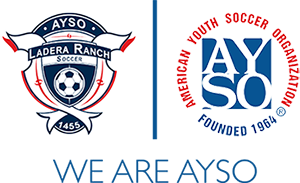While AYSO would love to provide every team at least half a field with a goal for every practice, there will sometimes be space restrictions that force coaches to share smaller spaces and/or rotate use of goals. Even still, there will be times before games that you need to practice (warm up) without much space and without goals. So here are 10+ generic drills that you can do with your team that allow for endless variety:
- Juggling – For the younger players, get them juggling in an open area and allow bounces between kicks. Then constrain them to an area, then smaller area until they can get to certain amount. Then add a certain number of bounces allowed to get to [5, 10, etc]. Then have them incorporate other parts of the body. Then have them perform specific combinations in order (left foot, left thigh, left shoulder, head, right shoulder, etc etc). The point is that you can always devise a more difficult challenge depending on the age/skill level of your players. Juggling should be a part of every practice and warm up. See the articles for Juggling and Pre Game for more
- Ball Control Progression – Teach footwork and dribbling skills . This article covering this concept in depth, but essentially you are having them stand spread out on the edges of one or more coned squares. You demo a foot skill technique such as moving the ball with the outside or their foot, the sole of their feet, performing V or L cut turns etc. There are dozens of examples provided in the article. They then dribble across the square performing the movements at speed and in close quarters. A full 14 player squad can do this in 2 8×8 squares
- Rondos – A Spanish term for any drill that involves keep away (possession) in an overloaded fashion (e.g. 6 v 2). The most typical variety is laying out a circle of cones, having everyone standing just inside the circle with 1 or more players in the middle trying to intercept the ball as it’s passed around. The player in the middle touching the ball or closest to the error switches out with the player at fault for giving away possession. There is a short (and free) book you cant rent via Amazon Kindle called The Science of Rondos which illustrates many additional varieties of this exercise. The bigger the space and the greater the overload ratio, the easier it is for the players
- Paired skill work – Having all players pair off you can perform any sort of trapping and passing work. Examples for younger players include correct passing form, passing with non-dominate foot, passing with outside of foot, 2 touch passing and 1 touch passing. Trapping can include wedge stop, inside stop, or outside stop, with both or specific feet. You can increase the difficulty of trapping by asking the passing player to overweight the pass, pass slightly off target, or move them closer together to reduce reaction time. With older players you can incorporate throw-ins or even have the delivering player pick the ball up and deliver a high or difficult ball which allows them to practice thigh or chest control. This works well for goalkeeper warm ups as well, allowing the pair to catch the ball correctly. There are fun games (see Target Practice) that you can adapt with the pairs in this formation
- Trio skill work – Working in 3’s is very good for incorporating any type of movement-based training such as with dribbling and feints. Passing on the move is great with this setup too. For example, you have them line up just like they were paired off, but you have one player waiting in line behind one of the other players. The side with one player begins with the ball dribbling toward the side with two players, the 1st player on the other side comes to middle to act as a defender, the player with the ball performs a specific dribble or feint past the defender, then passes the ball to the player in line while the defender continues on the other side. That player then takes off toward the other side and repeat. Wider spaces increase conditioning (more distance to cover), the skills/feints can be as difficult and varied as you like
- Possession-based – All of the specific attributes of coaching possession-based soccer have drills associated with them that don’t require goals or much space. These topics include shielding, movement off-ball, passing angles etc.
Most if not all of the activities in the AYSO coaching manuals and USSF session plans meet our criteria as well, so have a review of these resources if you want to focus on specific topics. Note that AYSO manuals are more fun/game oriented and USSF plans are more tactic/skill focused.



Leave A Comment